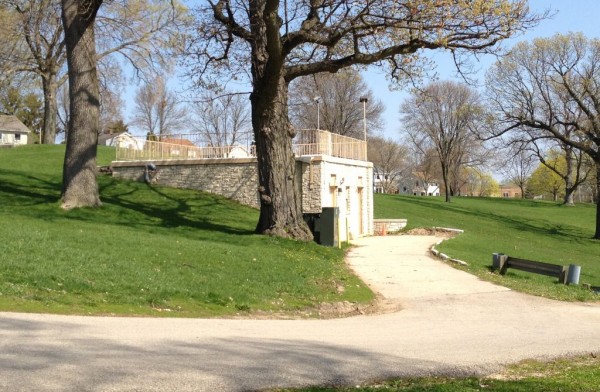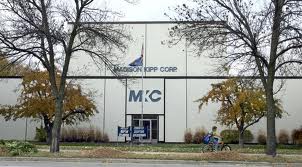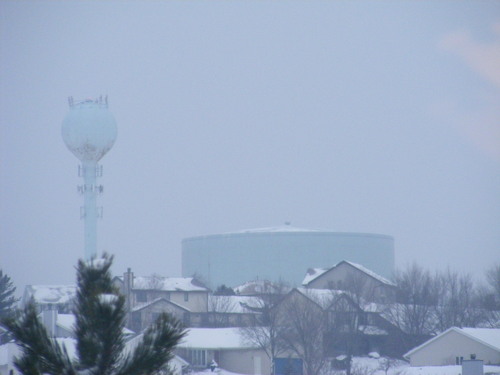Water Utility says nearby Kipp contamination not a concern

Deep Well #8 on the Olbrich sledding hill. This seasonal well is the last of the 22 wells to be activated by the city in their drought response.
We’re not sure if Madison is running out of water, but as part of its drought response, the city has activated its last remaining dormant well as a precaution. Well #8, located at Welch and Lakeland Avenues also known as the Olbrich sledding hill, is in the process of being flushed so it will be ready in case demand increases again. The well has been dormant until now and some are raising concerns about water quality since its blocks from the Madison-Kipp Corporation plant where ground contamination has been an on-going concern.
In a letter to Madison 6th Ward Alder Marsha Rummel, Madison Water Utility Public Information and Conservation Official Gail Gawanda said that flushing of Well #8 began the week of July 17. The well is being placed in service as a precaution since all the other wells and booster stations are running at nearly non-stop pace to meet current demands.
The Water Utility is concerned that one pump failure in the system could have a cascading effect on supply and thus having this well on standby will guard against disruptions. In addition, the extra capacity is needed to support any possible fire fighting operations due to drought or other fire fighting need.
Waking up a dormant deep well takes a few steps. First the well and its reservoir will be flushed into Lake Monona until iron and manganese levels stabilize. Once that phase is passed the well and the water it supplies will be tested for bacteria. If none is found, the well will be placed into service about four hours a day to keep circulation going so that the water in it’s reservoir remains fresh and fully chlorinated.
Approximately 400,000 to 500,000 gallons of water will enter the system each day from Well #8 which Gawanda tells Willy Street Blog is a seasonal well since it’s older and has higher levels of minerals in the water. Gawanda said they are anticipating the well to become operational as early as Monday July 23.
“[The engineers] have been hesitant to use this well in the past due higher levels of manganese and iron which are only aesthetic concerns because they can cause discoloration of the water,” Gawanda said. She added that they are in the process of installing a filter to reduce the levels of these minerals but that will take several years.
Concerns about Kipp

Madison’s water utility says that contamination from the Kipp plant will take at least 50 years to reach Well #8. The utility will be drilling a new monitoring well next week. Courtesy: Eastsidehistory.wordpress.com
On the news that the well would become active, area residents expressed concern that the contamination plume that has been detected below the Madison Kipp plant on Atwood Avenue feeds into Well #8.
Gawanda says that the Water Utility is monitoring the plume and plans to drill a new monitoring well next week that will add to the ones already in place. She added that engineers say the movement of the plume will take approximately 50 years for it to threaten the underground water supply that is tapped by the well.
“If we ever detected those contaminates in the well we wouldn’t operate it ever,” Gawanda said. “We would fill it in with cement.”
In talking to Gail Gawanda, we found out a few interesting facts about Madison’s water system and how our water is supplied. Some time ago city planners wanted to avoid Madison becoming a “Mushroom City”.
That is, water towers everywhere to help maintain pressure in the pipes below ground. In order to have the skyline aesthetic we currently enjoy, pumping stations, wells, and reservoirs are set up around the city to maintain pressure.

Madison still has a few water towers, but at the edges to avoid becoming what planners long ago said would be a “Mushroom City”.
Gawanda says we still have a few water towers, but they are at the edges of the city including out past East Towne Mall. Madison also has at least one standpipe, which is just a big cylinder full of water; tall buildings use this type of method to provide water for firefighting on every floor.
In addition to the infrastructure, the city also manages the supply at another level by maintaining 11 pressure zones within the system to meet demand. Well #8 will be on standby through the end of the summer. You can find out more about the Madison Water Utility here.

